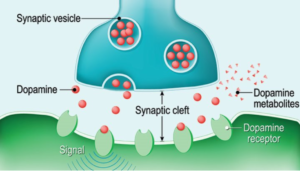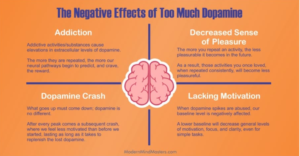A Tutorial on the Brain and Dopamine
Written by: Sahasra Janagama
What is Dopamine? Is it just a “feel-good” hormone, or is there more than what meets the eye? Dopamine is usually associated with a surge of energy, but it plays various roles involving movement, memory, mood, and motivation. It’s a neurotransmitter that sends messages throughout the body whenever it senses a “good” sensation from the external environment. Let’s unpack how dopamine functions on a daily basis and how it can affect us.
What is it?
As mentioned before dopamine can act in different ways when working with the human body. For example, Dopamine is more than just a “feel-good hormone”, but also the reward-center for the body. It acts as the home for any feeling of pleasure the body feels throughout the day, and it adds these pleasurable activities to the reward system whenever looking for a surge of dopamine. For example, students who are usually mentally drained take multiple doses of coffee to boost their focus on their work. The students are indirectly boosting their dopamine hormones throughout their nervous system. Similar to how kids act during Halloween, as children usually become hyperactive after eating an extensive amount of candy. Again, the children are also experiencing a boost of energy, as the dopamine system identifies the candy as “pleasure” and creates a good experience (Dopamine, 2022).
Figure 1

Diagram illustrating what happens with Dopamine at a microscopic level within the nervous system.
Source: EverydayHealth
Effects on the Body?
After knowing what it is, it’s important to understand the effects Dopamine has on the body, as it can explain how you function on a day-to-day basis. People who have a good balance of dopamine levels are usually happy and feel content throughout the day. However, those who have an unbalanced level of dopamine will feel different sides of the spectrum. For example, they could experience a spike in dopamine levels in the morning after going on a morning jog, and by the time the day ends they can experience a severe dip in dopamine because not accomplishing all their goals due to fatigue after the run.
Another keynote is the use of artificial dopamine, this could be harmless or harmful depending on the dosage and what type of artificial “drug” a person is taking. For instance, if a person drinks multiple cans of soda and caffeine for a day to boost their productivity, it will temporarily increase their dopamine levels increasing the dopamine levels but would have serious consequences like memory loss (if this routine is repeated multiple times) or trouble concentrating and sleeping. More serious consequences of dopamine imbalances can be caused by the usage of drugs such as nicotine, cocaine, and methamphetamine. Although Dopamine is not directly associated with addiction, it still plays an indirect role. Dopamine’s reward center adds the cues of getting the drug into the body’s system as an “achievement” because, Dopamine only sees it as another effective way to get the pleasurable feeling. Furthermore, methamphetamine and other drugs have a much longer duration of “feeling-good” that causes them to be on the top of the reward list, and this causes Dopamine to increase demand for the drug. The consequence of this is the direct contact of the brain and the drug which will affect the brain functions, and how it gives commands to the rest of the body. This is why it’s important to note what we take in, as once it goes in, it gets added to the system and it’s hard to reverse it once it’s added (Dellwo, 2024).
Figure 2

Infographic illustrating and elaborating on the negative side effects of excessive levels of dopamine in the nervous system.
Source: Modern Mind Masters
Conclusion
Dopamine can be scary, but delightful pleasure, depending on how you use it. While dopamine is largely believed to only be an energy-boosting hormone, it also plays a huge part in different parts of our brain and body. Dopamine is vital to our balance in living a mentally stable life, it can also cause trouble sleeping and aggression. So watch out for what might trigger the pleasurable feeling of Dopamine. It is important to consider the effects surrounding dopamine spikes and what is causing them.
References
Dellwo, A. (2024, November 2). Dopamine: Function, Symptoms of High and Low Levels. Verywell Health. Retrieved November 25, 2024, from https://www.verywellhealth.com/dopamine-5086831
Dopamine. (2022, March 23). Cleveland Clinic. https://my.clevelandclinic.org/health/articles/22581-dopamine
Konkel, L., & Church, K. (n.d.). What Is Dopamine? Everyday Health. Retrieved November 25, 2024, from https://www.everydayhealth.com/dopamine/